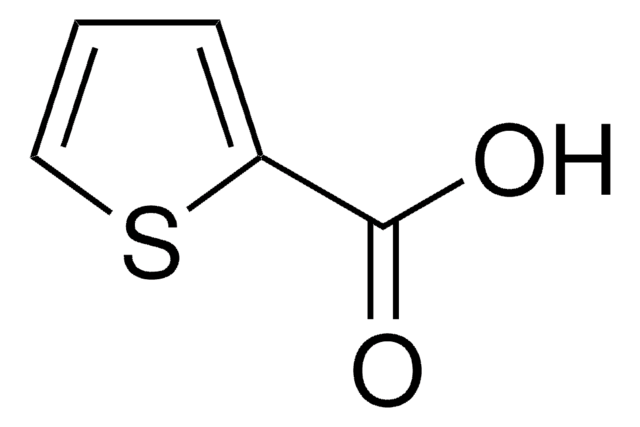W392103
2,4-Hexadiensäure
≥99%, FCC
Synonym(e):
Sorbinsäure, α-trans-γ-trans-Sorbinsäure, (E,E)-1,3-Pentadien-1-carbonsäure, 2,4-Hexadiensäure, 2E,4E-Hexadiensäure, trans,trans-2,4-Hexadiensäure, C6:2n-2,4, NSC 35405, NSC 49103, NSC 50268
About This Item
Empfohlene Produkte
Biologische Quelle
synthetic
Agentur
meets purity specifications of JECFA
Einhaltung gesetzlicher Vorschriften
FCC
FDA 21 CFR 166.110
FDA 21 CFR 172.872
FDA 21 CFR 177.2260
FDA 21 CFR 181.23
FDA 21 CFR 182.3089
Dampfdruck
0.01 mmHg ( 20 °C)
Assay
≥99%
Form
powder
mp (Schmelzpunkt)
132-135 °C (lit.)
Löslichkeit
ethanol: 10%, clear, colorless to slightly yellow
Dichte
1.2 g/cm3 at 20 °C
Kationenspuren
As: ≤3.0 ppm
Cd: ≤1.0 ppm
Hg: ≤1.0 ppm
Pb: ≤2.0 ppm
Anwendung(en)
flavors and fragrances
Dokumentation
see Safety & Documentation for available documents
Nahrungsmittelallergen
no known allergens
Organoleptisch
odorless
SMILES String
C\C=C\C=C\C(O)=O
InChI
1S/C6H8O2/c1-2-3-4-5-6(7)8/h2-5H,1H3,(H,7,8)/b3-2+,5-4+
InChIKey
WSWCOQWTEOXDQX-MQQKCMAXSA-N
Suchen Sie nach ähnlichen Produkten? Aufrufen Leitfaden zum Produktvergleich
Signalwort
Warning
H-Sätze
Gefahreneinstufungen
Eye Irrit. 2 - Skin Irrit. 2
Lagerklassenschlüssel
11 - Combustible Solids
WGK
WGK 1
Flammpunkt (°F)
260.6 °F - closed cup
Flammpunkt (°C)
127 °C - closed cup
Persönliche Schutzausrüstung
dust mask type N95 (US), Eyeshields, Gloves
Analysenzertifikate (COA)
Suchen Sie nach Analysenzertifikate (COA), indem Sie die Lot-/Chargennummer des Produkts eingeben. Lot- und Chargennummern sind auf dem Produktetikett hinter den Wörtern ‘Lot’ oder ‘Batch’ (Lot oder Charge) zu finden.
Besitzen Sie dieses Produkt bereits?
In der Dokumentenbibliothek finden Sie die Dokumentation zu den Produkten, die Sie kürzlich erworben haben.
Kunden haben sich ebenfalls angesehen
Unser Team von Wissenschaftlern verfügt über Erfahrung in allen Forschungsbereichen einschließlich Life Science, Materialwissenschaften, chemischer Synthese, Chromatographie, Analytik und vielen mehr..
Setzen Sie sich mit dem technischen Dienst in Verbindung.










